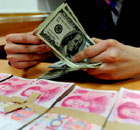-
-
China Daily E-paper
Op-Ed Contributors
China-bashing based on bad economics
By Stephen S. Roach (China Daily)
Updated: 2010-04-07 07:58
 |
Large Medium Small |
In 2009, the broadest measure of domestic US savings - the net national savings rate - fell to a record low of a -2.5 percent of national income. This is the sum total of depreciation-adjusted savings by households, businesses, and the government sector. Depreciation is removed to get a sense of how much savings are left - after providing for the normal obsolescence of antiquated or worn-out capacity- for the expansion of capital stock. In the case of the US, there isn't any. That means the US must import surplus savings from abroad to fund the sustenance of its future growth.
This is where China enters the equation. In order to attract the foreign capital that the US needs to sustain its growth, the US must then run a large current account deficit. In the case of the US, the cross-border multilateral trade deficit in goods and services has accounted for an average of 95 percent of the total current account deficit over the past five years. In other words, for a US economy without savings, there is no escaping large multilateral trade imbalances.
Yes, China is the biggest piece of America's multilateral trade deficit. But that is because high-cost US companies are increasingly turning to China as a low-cost offshore solution. And it also reflects the preferences of US consumers for low-cost and increasingly high-quality goods made in China. In other words, the US is actually quite fortunate to have China as a large trading partner.
No, China is hardly perfect. Like the United States, it, too, has a large imbalance with the rest of the world - namely, an outsized current account surplus. And just as responsible global citizenship requires the US to address the savings deficiency that lies at the heart its international imbalances, the world has every reason to expect the same from China in reducing its surplus savings. Those adjustments must be the essence of any successful global rebalancing agenda.
But these adjustments must be framed in the multilateral context in which the imbalances exist. Just as China is one of over 90 countries that the US runs trade deficits with, US-China trade now represents only 12 percent of total Chinese trade with the rest of the world. Consequently, it is wrong to fixate on the relative price between these two nations - specifically, the foreign exchange rate between the US dollar and the Chinese renminbi - as the solution for the deeply rooted savings disparities that drive these multilateral imbalances.
Yet some of America's most prominent economists are saying the opposite - claiming that a revaluation of the renminbi vis--vis the dollar would not only create over one million jobs in the US but that it would inject new vigor into an otherwise anemic global recovery. Economists should know better. Changes in relative prices are the ultimate zero-sum game - they re-slice the pie rather than expand or shrink it. When nations have large imbalances with a large cross-section of their trading partners - as is the case with both China and the US - there can be no bilateral solution.
Currency, or relative price, adjustments between two nations are not a panacea for structural imbalances in the global economy. What is needed, instead, is a shift in the mix of global savings. Specifically, the US needs deficit reduction and an increase in personal savings, while China needs to stimulate internal private consumption.
Washington's scapegoating of China could take the world to the brink of a very slippery slope. It wouldn't be the first time that political denial was premised on bad economics.
But the consequences of such a blunder - trade frictions and protectionism - would make the crisis of 2008-09 look like child's play.
The author is the chairman of Morgan Stanley Asia and author of The Next Asia.
(China Daily 04/07/2010 page9)









